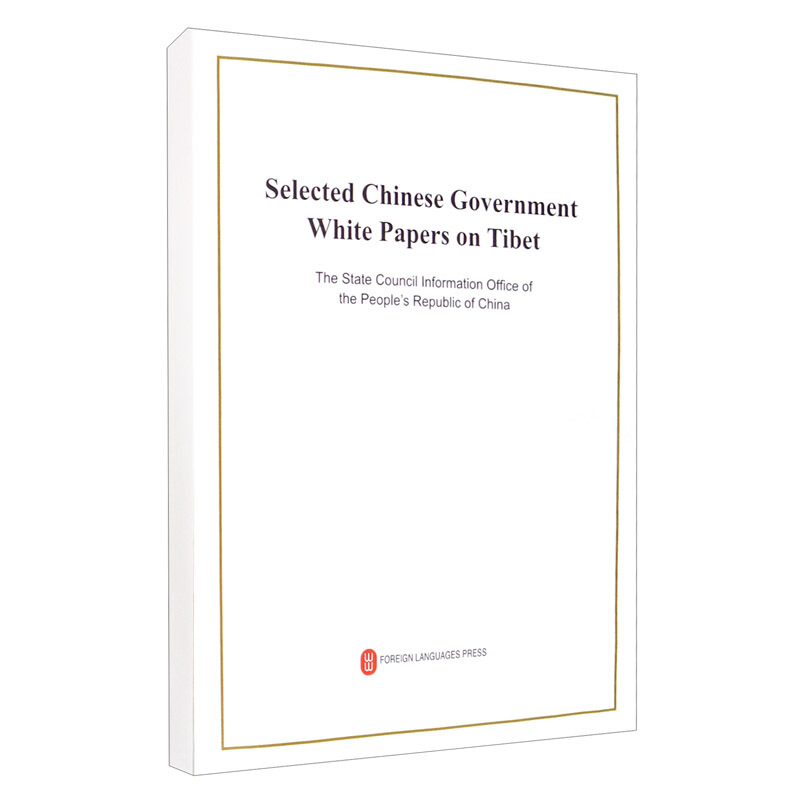
Selected Chinese government white paper on tibet

- ISBN:9787119123509
- 装帧:一般胶版纸
- 册数:暂无
- 重量:暂无
- 开本:26cm
- 页数:242页
- 出版时间:2020-01-01
- 条形码:9787119123509 ; 978-7-119-12350-9
内容简介
《中国政府涉藏白皮书选编(英)》主要收录了2008年至今国务院新闻办公室发表的5个以西藏为主题的白皮书,包括《伟大的跨越:西藏民主改革60年》《青藏高原生态文明建设状况》《民族区域自治制度在西藏的成功实践》《西藏发展道路的历史选择》《西藏文化的保护与发展》。
目录
March 2019
Preamble
Ⅰ.Feudal Serfdom: A Dark History
Ⅱ.Irresistible Historical Trend
Ⅲ.Abolishing Feudal Serfdom
Ⅳ.The People Have Become Masters of Their Own Affairs
Ⅴ.Liberating and Developing the Productive Forces
Ⅵ.Promoting a Range of Undertakings
Ⅶ.Enhancing Ecological Progress
Ⅷ.Protecting the Freedom of Religious Belief
Ⅸ.Strengthening Ethnic Equality and Unity
Ⅹ.Development of Tibet in the New Era
Conclusion
Ecological Progress on the Qinghai-Tibet Plateau
July 2018
Preamble
Ⅰ.An Improving System for Ensuring Ecological Progress
Ⅱ.Prominent Progress in Ecosystem Conservation
Ⅲ.Steady Improvement of Environmental Quality
Ⅳ.Steady Development of Green Industry
Ⅴ.Sci-tech Support System Is in Place
Ⅵ.A Developing Culture That Values Ecological Awareness
Conclusion
Successful Practice of Regional Ethnic Autonomy in Tibet
September 2015
Preface
Ⅰ.Old Tibet: Dark and Backward
Ⅱ.Embarking on the Road to Development and Progress
Ⅲ.The Political System Suited to China's Actual Conditions
Ⅳ.The People as Masters of the Country
Ⅴ.Improving People's Welfare
Ⅵ.Protecting and Carrying Forward the Excellent Traditional Culture
Ⅶ.Respecting and Protecting Freedom of Religious Belief
Ⅷ.Promoting Ecological Progress
Conclusion
Tibet's Path of Development Is
Driven by an Irresistible Historical Tide
April 2015
Foreword
Ⅰ.The End of the Old System Was a Historical Inevitability
Ⅱ.New Tibet Follows a Sound Path of Development
Ⅲ.The Essential Intent of the "Middle Way" Is to Split China
Ⅳ.A Veneer of Peace and Non-violence
Ⅴ.The Central Government's Policy Towards the 14th Dalai Lama
Conclusion
Protection and Development of Tibetan Culture
September 2008
Foreword
Ⅰ.Learning, Use and Development of the Spoken and Written Tibetan Languages
Ⅱ.Inheritance, Protection and Promotion of the Tibetan Cultural Heritage
Ⅲ.Religious Beliefs and Native Customs Respected
Ⅳ.All-round Development of Modem Science, Education and the Media
Conclusion
节选
In 1963, the Plateau delineated its first state nature reserve now the Baishuijiang State Nature Reserve). The Regulations of the People's Re-public of China on Nature Reserves, promulgated in 1994,-defined the ranking system, the management structure and the function zones of na-ture reserves, ushering in a period of rapid development of nature reserves on the Plateau. To date, the Plateau has established in total 155 nature reserves at all levels (41 state and 64 provincial ones), covering a total area of 822,400 sq km. This is equivalent to 31.63 percent ofthe Plateau's landmass and represents 57.56 percent of China's land nature reserve ar-eas. Basically, all of the Plateau's unique and fragile ecosystems and rare species can be found in these reserves.As China reforms its system for ecological progress, the govern-ment has issued a directive to establish a system of protected natural areas, with state parks as the main element. In 2016, the state ratified the Plan for the Trial Run of the State Park at Sanjiangyuan (literally,source of three large rivers), the first pilot reform program to introduce state parks in China. The core aim is to make sure that the ecological resources of the Sanjiangyuan area, where the headwaters of the Yangtze River, Yellow River and Lancang River converge, are owned by the state,shared by the people, and passed down to future generations. The Regula-tions of Sanjiangyuan State Park (Trial), issued by Qinghai Province, de-fines clear provisions on the parks' management in terms of background survey, targets of protection, ownership structure, assets and liabilities,biodiversity preservation, environmental monitoring, cultural legacy pro-tection, ecological compensation, disaster prevention and reduction, and inspection and quarantine. In January 2018, the National Development and Reform Commission released the Overall Plan of Sanjiangyuan State Park, which further clarified the principles of running the park, its layout,functions, and management targets. The park will serve as a role model to guide green development on the Qinghai-Tibet Plateau and in surrounding areas.An ecological compensation mechanism is in place.The ecological compensation mechanism is an important step taken by the state to protect the environment. In the Qinghai-Tibet Plateau re-gion, China has initiated a series of ecological compensation mechanisms,including transfer payments to key ecological function zones, forest eco-logical benefit compensation, grassland ecological protection subsidy and reward, and wetland ecological benefit compensation. In 2008-2017, the central government made transfer payments of RMB16.29 billion and RMB8.35 billion to the key ecological function zones in Qinghai and Tibet, covering 77 key counties and all areas prohibited to development by the state.Since the lOth Five-year Plan period (2001-2005), Tibet Autonomous Region has received RMB31.6 billion in ecological compensation for its forests, grasslands, wetlands, and key ecological function zones. Dur-ing the 12th Five-year Plan period (2011-2015), the state paid a total of RMB10.9 billion to Tibet in grassland conservation subsidy and rewards.Since 2015, the autonomous region has been experimenting with a com-pensation program for damage caused by wildlife, mitigating herdsmen's losses to a total amount of RMB85 million.Funds to encourage ecological progress in Qinghai Province have been increased. Since 2013, the central government has allotted a total of RMB16.4 billion in ecological compensation for grasslands, forests and wetlands in Qinghai. To integrate conservation and poverty reduction,Qinghai has initiated a public ranger program to monitor the environment,with an annual subsidy of RMB880 million. Since the 12th Five-year Plan period the state has helped 622,300 farming and herding households in Qinghai to obtain better housing, provided clean drinking water to 1.6million people, and ensured reliable power access to 650,000 people.This represents a considerable improvement of quality of life. In Deqen Prefecture of Yunnan Province, an ecological compensation mechanism for public benefit forests has been in place since 2009, receiving a total of RMB1.1 billion in state subsidies by 2017. ……
-

毛泽东选集(全四册)
¥73.1¥97.5 -

为什么是中国(九品)
¥29.0¥58.0 -

毛泽东选集(普及本)(全四册)
¥52.8¥81.0 -

走向海洋(八品)
¥16.2¥59.8 -

兄弟连-纪念版
¥19.0¥38.0 -

论共产党员的修养
¥2.3¥5.5 -

马克思主义:赞成与反对
¥9.5¥35.0 -

走向海洋
¥16.1¥59.8 -

秘密访问-中美关系破冰亲历
¥9.0¥28.0 -

中国的婚姻与家庭
¥15.1¥39.8 -

毛泽东选集-(第三卷)
¥14.6¥18.0 -

(平装)二战战史
¥11.7¥45.0 -

浴血荣光
¥16.2¥45.0 -

步兵攻击:隆美尔手绘插图珍藏本
¥13.5¥45.0 -

国之脊梁:中国科学家的家国天下
¥37.7¥59.8 -

1793乾隆英使觐见记(九品)
¥9.8¥39.0 -

中国抗日战争史简明读本
¥12.3¥30.0 -

共产国际与广州国民政府关系史
¥16.8¥56.0 -

孙子兵法
¥11.5¥36.0 -

温家宝谈教育
¥20.7¥69.0











